Physical Address
304 North Cardinal St.
Dorchester Center, MA 02124
These diseases are all characterized by vascular damage of some type. Extravasated erythrocytes (1.40) often produce the appearance of purpura (1.120). Some of these diseases are considered to be true vasculitis. Vasculitis (literally, inflammation of the blood vessels) cannot be diagnosed with certainty unless there is visible vessel wall damage ( necrosis , hyalinization, or fibrin in the wall ) and inflammatory cells in vessel walls. Red blood cell extravasation , thrombi , and nuclear dust from leukocytoclasia of neutrophils are secondary, less specific findings frequently seen in vasculitis, but are not as important as finding vessel damage. Nuclear dust can be seen in any lesion that has many neutrophils (1.89). Vessel wall change without the inflammation is often called vasculopathy instead of vasculitis. Extravasation of erythrocytes (1.40) can be seen in many diseases without vasculitis. Thrombi (1.137) are also frequently seen in diseases other than vasculitis. Vasculitis is often imperfectly classified based upon the clinical presentation, type of predominant inflammatory cell (neutrophils, lymphocytes, or macrophages) and the type and caliber of vessels involved (small vessels, arteries, or veins). Most cases of cutaneous vasculitis involve small blood vessels and are neutrophilic (4.1). Causes of granulomatous vasculitis are listed in 1.51. Consider that overlap exists between these disorders.
In addition to the diseases listed in this chapter, vasculitis may be seen in several other diseases, as well (1.145).
Erythema induratum (nodular vasculitis, 16.6)
Erythema nodosum leprosum (12.12)
Herpes virus infections (14.2)
Lymphomatoid granulomatosis (24.6)
(see Fig. 4.1A–D )
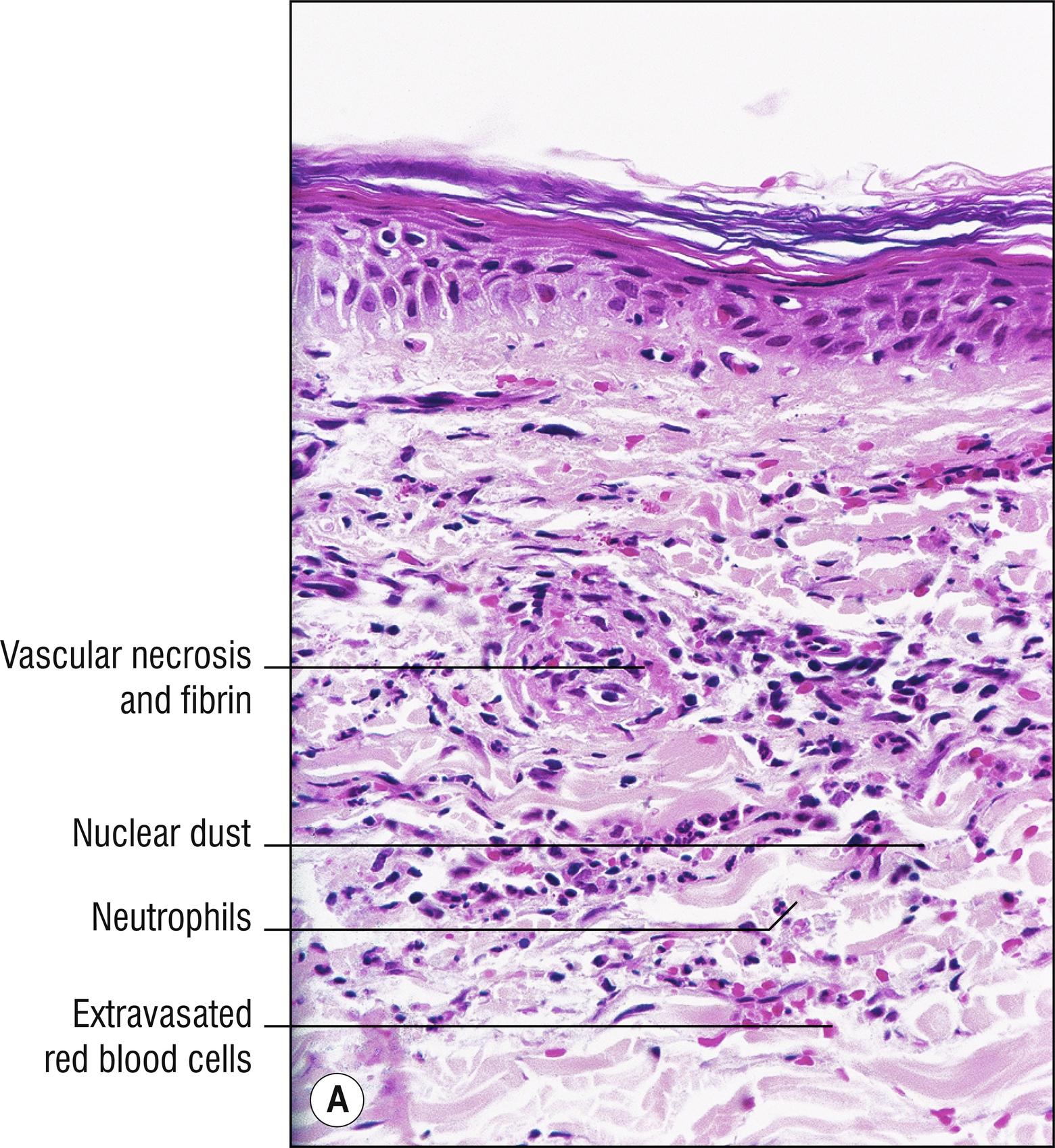
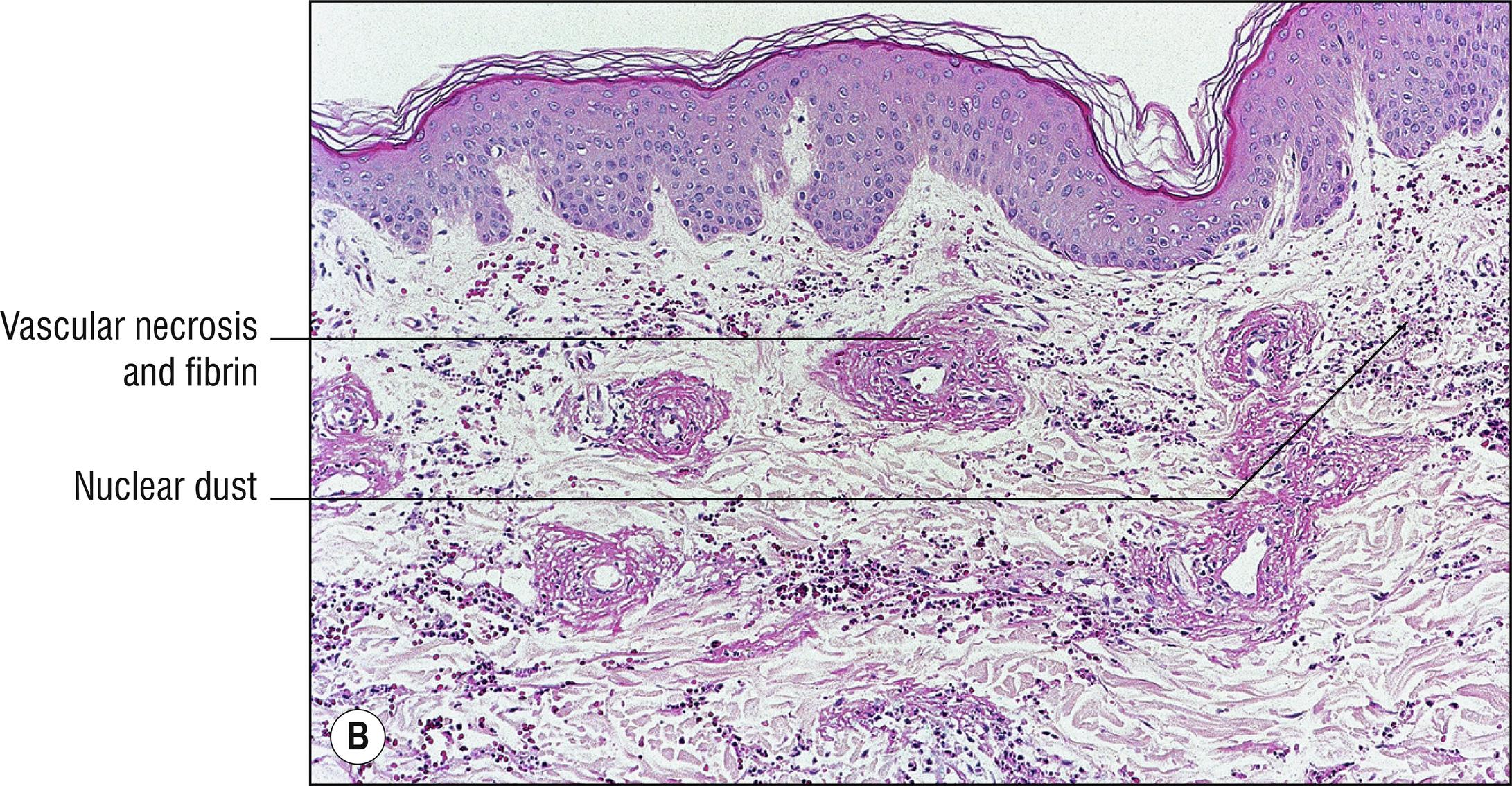
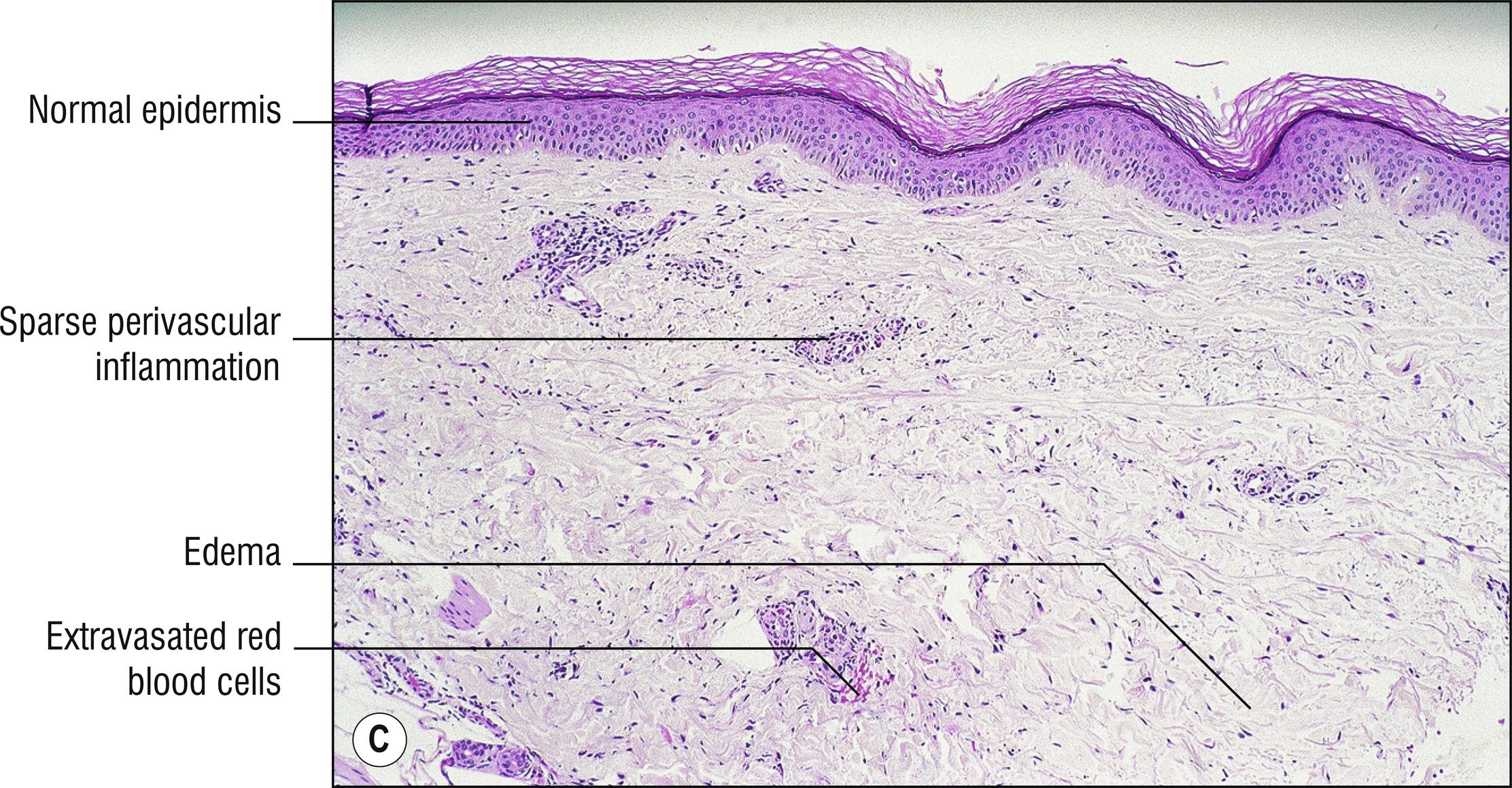
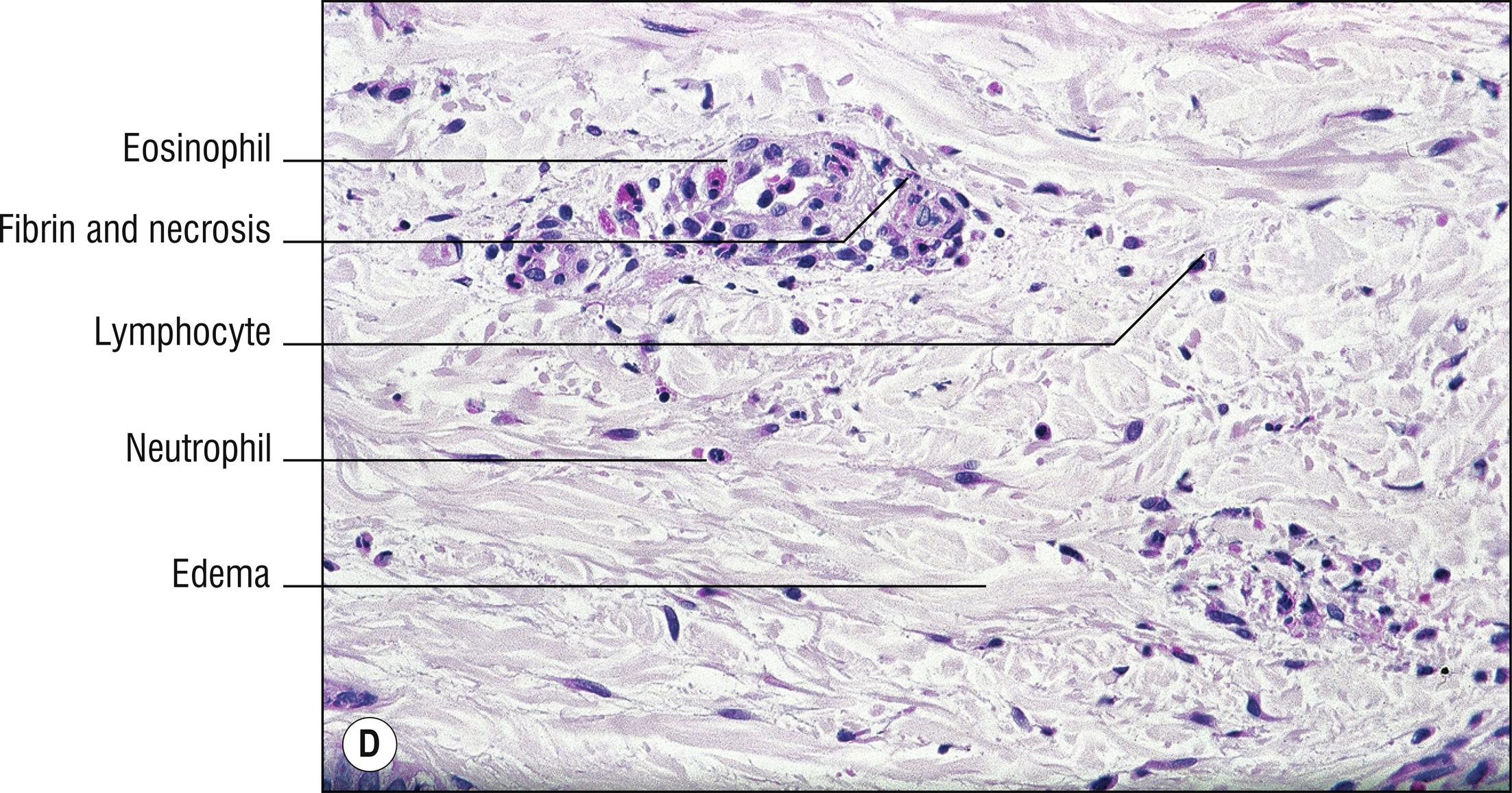
This is the most common type of vasculitis found in skin. Classically, palpable purpura appears on the legs (1.67), and may be painful (1.97). Vasculitis is often idiopathic, but may be caused by infections , drugs , or rheumatologic disorders. Systemic vasculitis may involve the kidneys (1.66), brain, or other organs.
Epidermis varies from normal to necrotic, sometimes with vesicles or pustules
Vasculitis of mostly small venules, with a predominant number of neutrophils ; sometimes eosinophils, lymphocytes, or histiocytes
Nuclear dust often
Red blood cell extravasation often
Thrombi sometimes
Direct immunofluorescence: usually not needed for diagnosis, reveals IgG, IgM, or complement in a granular pattern in the superficial blood vessels of early lesions of LCV. Fibrin deposits (“splash pattern”) may be seen in young or old lesions.
Henoch–Schönlein purpura (HSP, IgA vasculitis): distinct syndrome in children , rarely in adults, often idiopathic or due to streptococcal pharyngitis. Abdominal pain (1.49), bloody diarrhea, arthralgia or arthritis, hematuria, and palpable purpura more likely to become confluent, immunofluorescence more likely to show granular IgA in the superficial dermal blood vessels , usual self-limited benign course , resolves in a few weeks.
Urticarial vasculitis: clinical lesions more urticarial (3.1) than purpuric, persist in one place longer than urticaria , may be related to rheumatologic disorder or hypocomplementemia, biopsy more likely to show eosinophils than other types of vasculitis. Often has very little vessel changes, so that overlap with urticaria is a difficult diagnostic problem. In many cases there are only the usual pathologic changes of urticaria combined with red blood cell extravasation.
Septic vasculitis, acute and subacute bacterial endocarditis (SBE): vasculitic changes due to actual bacteria, fungi, or immune complexes in the skin lesions from a disseminated infection. Histology identical to ordinary LCV, must find infectious agent. Janeway’s lesions are acute, small, edematous red macules on acral skin from septic emboli, and Osler’s nodes are more chronic and painful nodules of acral skin. Gonococcemia (12.18) and meningococcemia (12.19) are also examples of septic vasculitis.
Bowel bypass syndrome: follows ileojejunal bypass (procedure generally no longer performed), more likely to have epidermal changes or pustules; true vasculitis not always present.
Pustular vasculitis: intraepidermal or subepidermal pustules in addition to usual changes of leukocytoclastic vasculitis.
Eosinophilic vasculitis: eosinophils prominent.
Acute hemorrhagic edema of infancy: children up to 3 years old, fever, edema of face and extremities, bright red purpuric ears , resolves spontaneously within 3 weeks like Henoch–Schönlein purpura, but no IgA is present.
Gougerot-Ruiter syndrome: chronic recurring LCV.
Other diseases with purpura (1.120).
Other disease with neutrophils in the dermis (1.89).
Other diseases with thrombi (1.137) or extravasation of erythrocytes (1.40).
Other diseases with vasculitis in this chapter.
(see Fig. 4.2A–C )
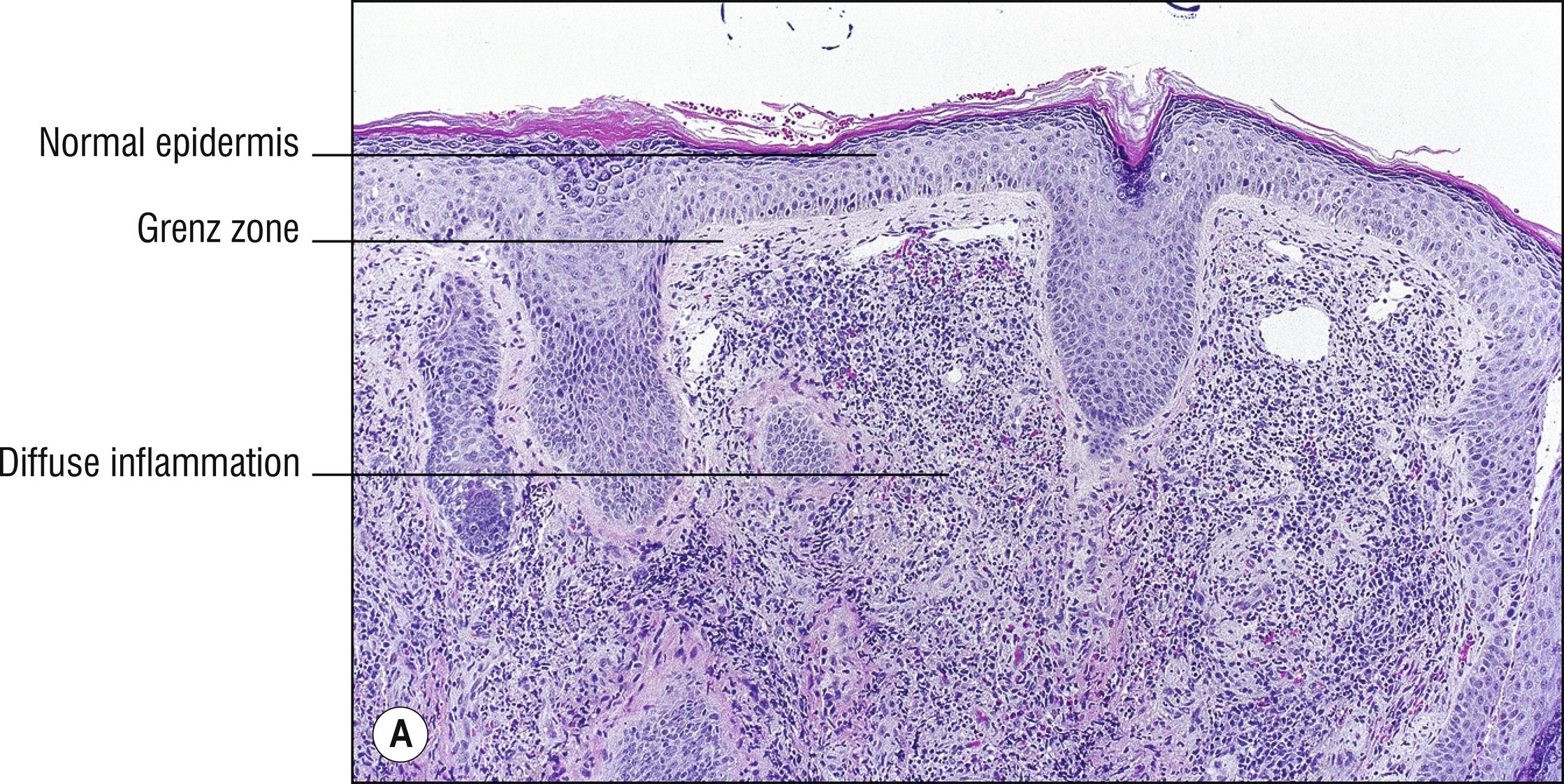
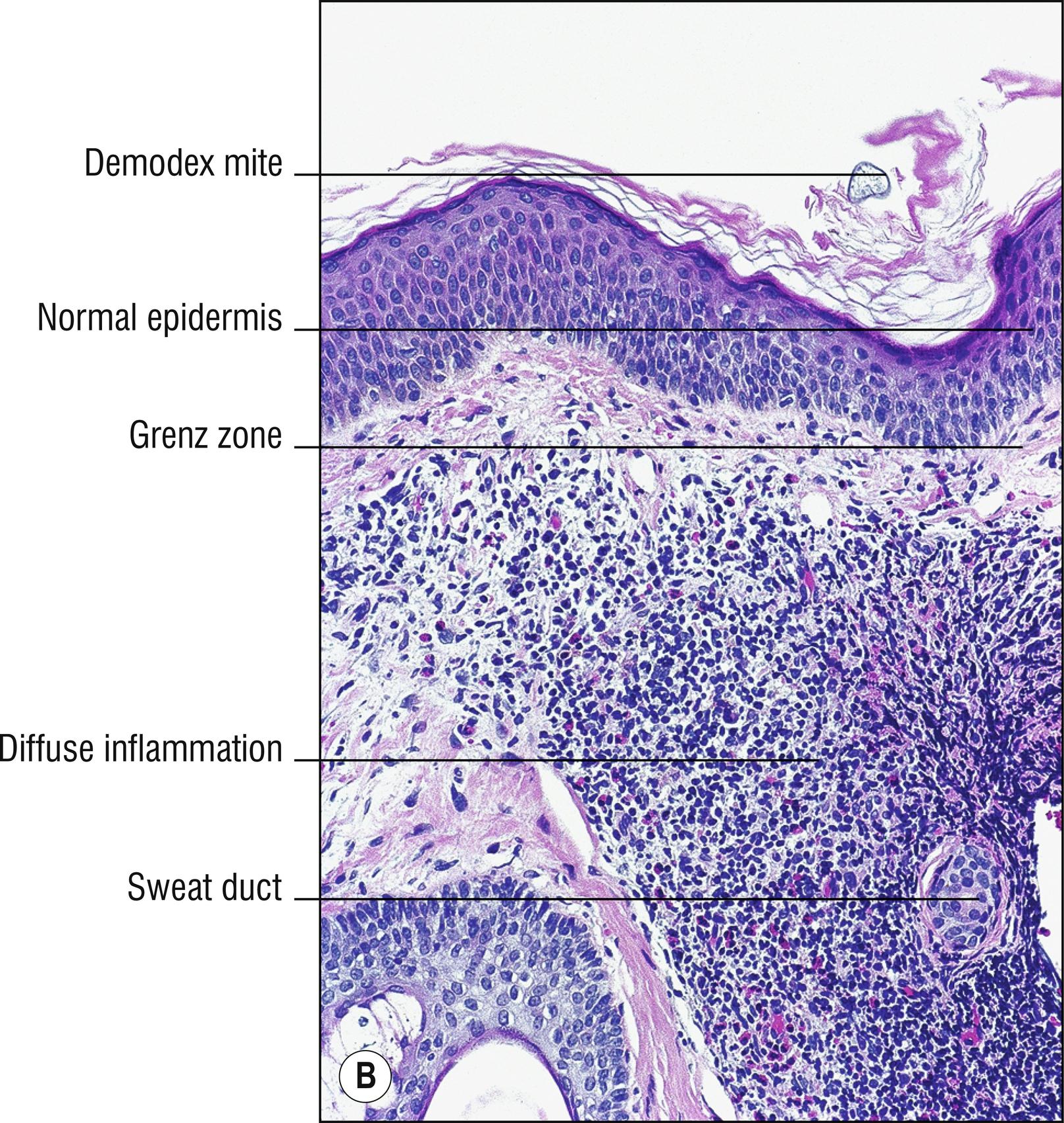
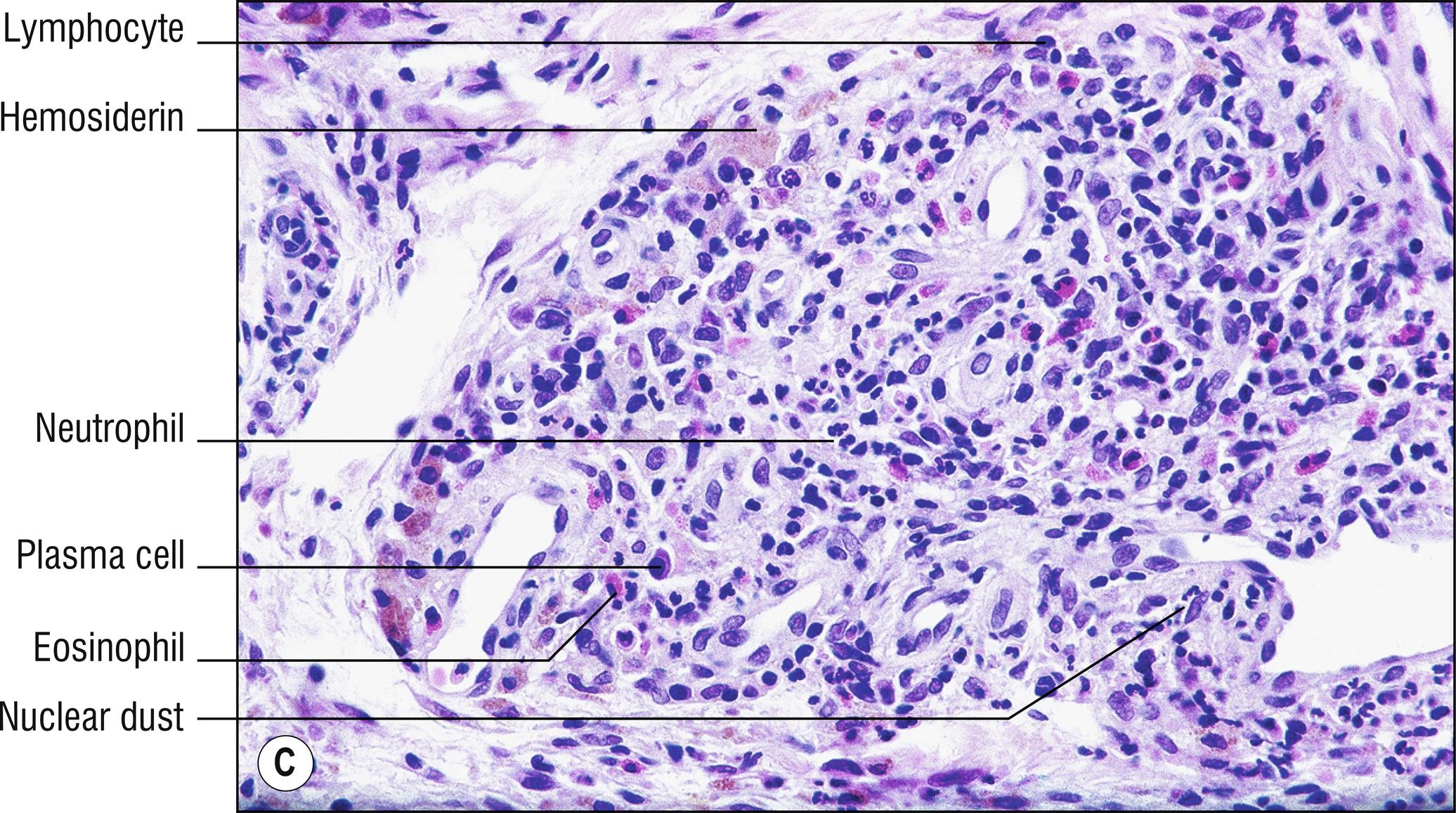
Uncommon, idiopathic brown–red plaques (1.18) on the face (1.44) of adults. GF is a misnomer, as there is no granuloma formation as defined in Section 1.35.
Epidermis is usually unremarkable
Grenz zone (1.49) above a diffuse mixed dermal neutrophils , eosinophils , lymphocytes , and histiocytes , sometimes with plasma cells or mast cells
Often leukocytoclastic vasculitis (4.1)
Often hemosiderin in dermis (1.58)
Other diseases with neutrophils in the dermis (1.30).
Other diseases with eosinophils in the dermis (1.31).
Other diseases with nodular or diffuse dermatitis (1.91).
(see Fig. 4.3A–C )

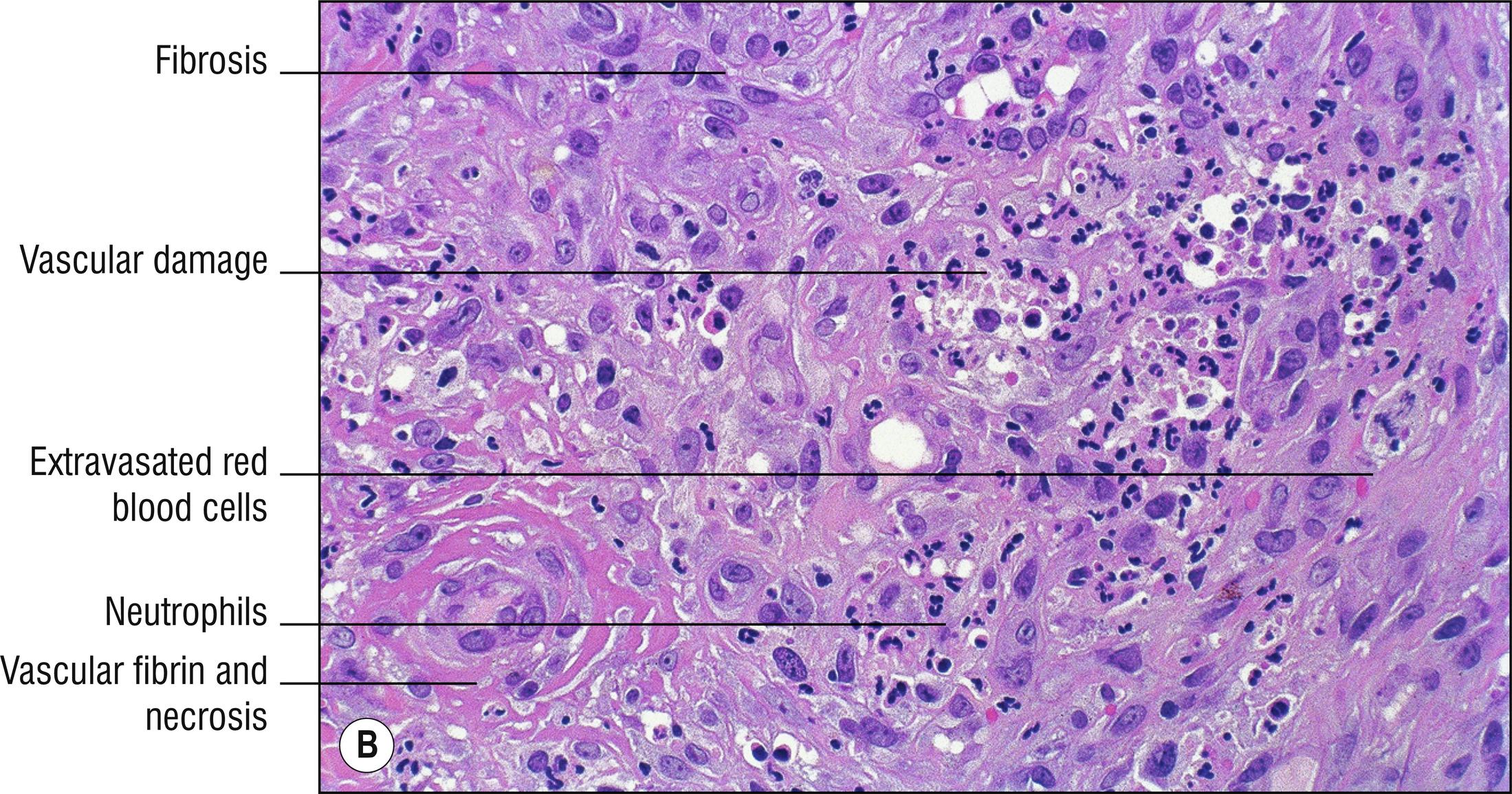

Rare, firm red to yellow – brown plaques (1.151), usually on extensor extremities , especially on the elbows (1.32), knees, and dorsal hands and feet (1.56). It is usually not associated with systemic vasculitis, but sometimes can occur with rheumatologic disorders or HIV infection (14.12). Some patients have monoclonal gammopathy (1.80).
Epidermis usually unremarkable
Leukocytoclastic vasculitis (less apparent in older lesions)
Fibrosis or lipid deposits (cholesterol clefts or “extracellular cholesterolosis”) in older lesions
Other diseases with neutrophils in the dermis (1.30) or fibrosing disorders (1.125).
(see Fig. 4.4A–C )
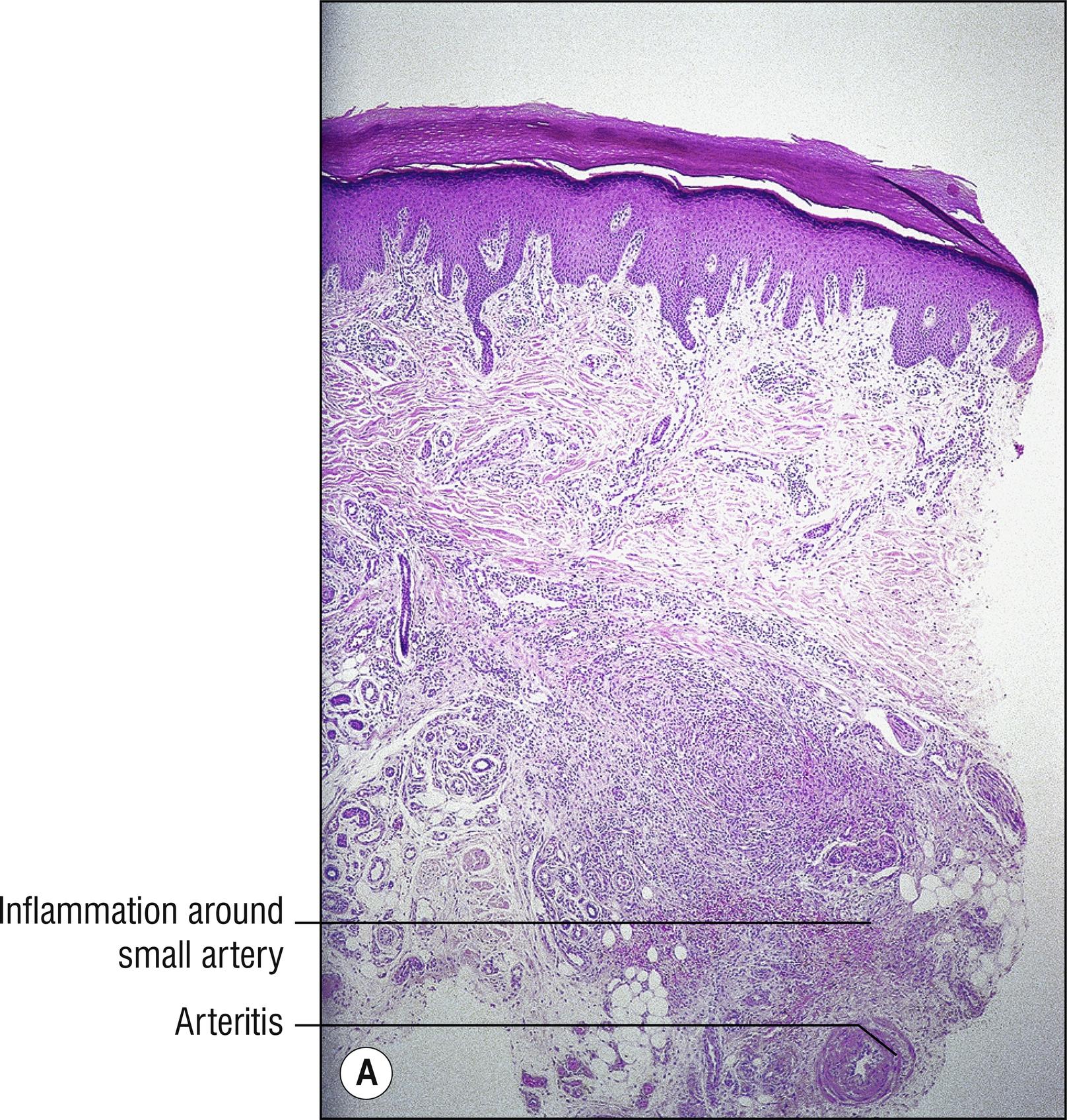
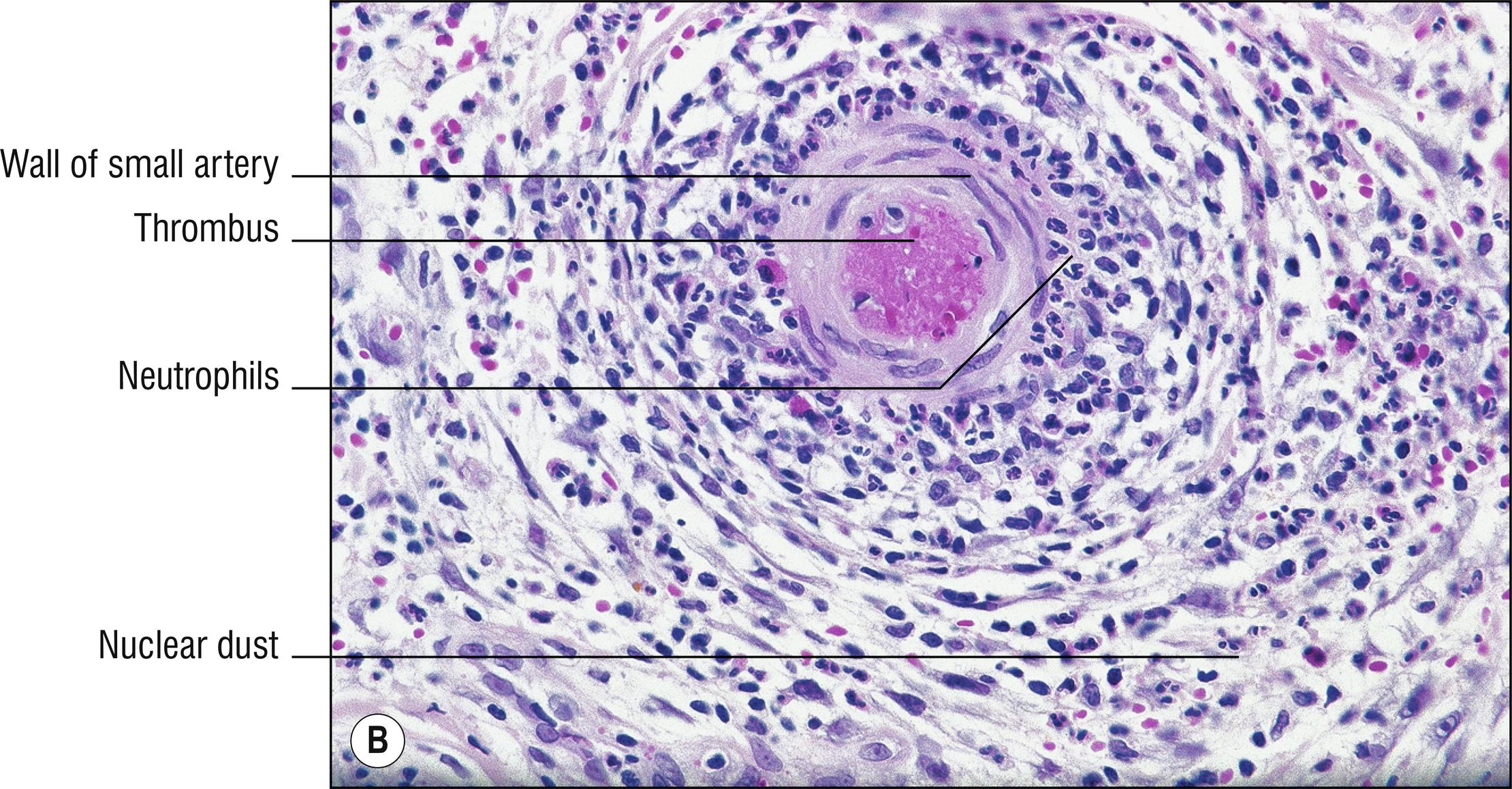
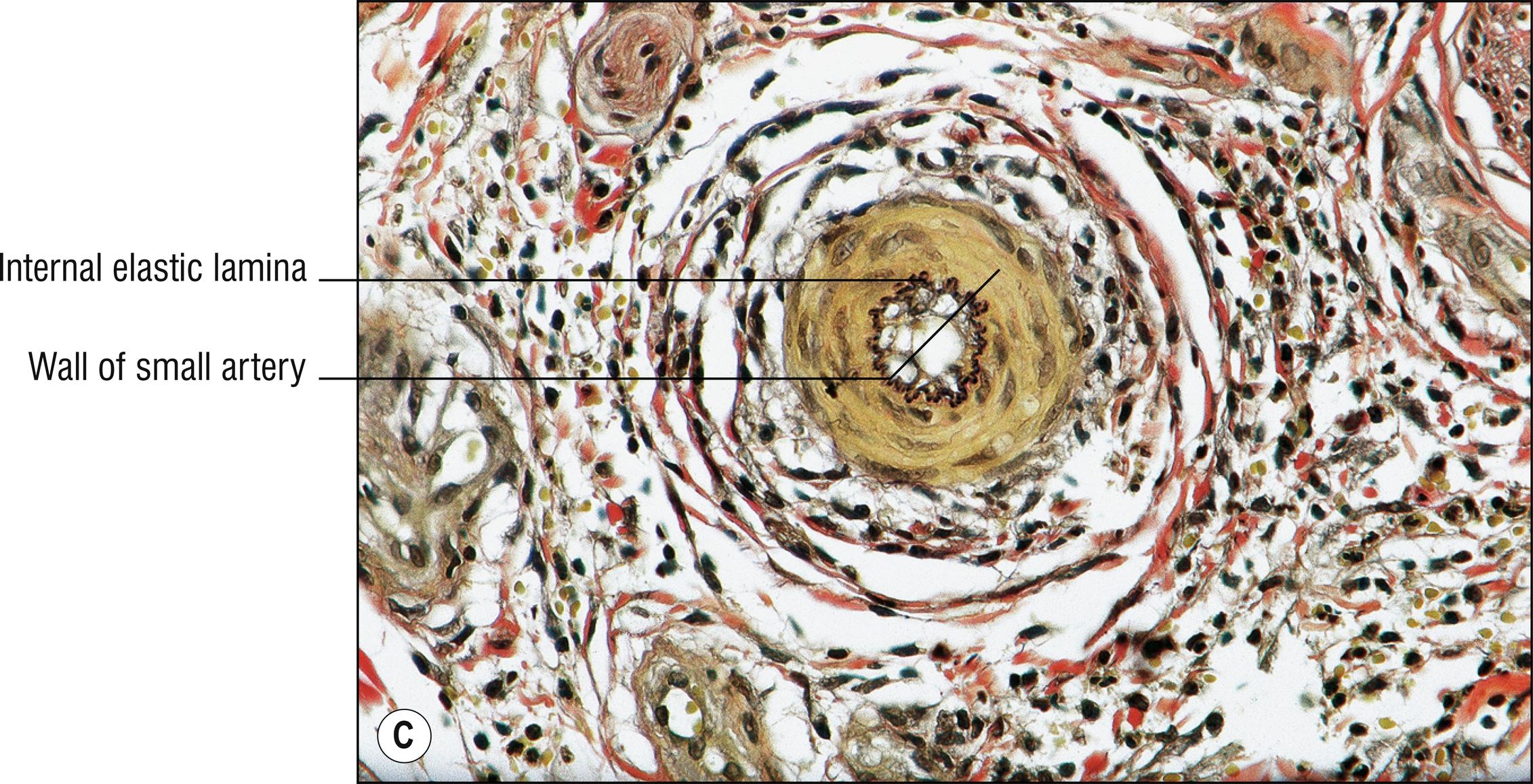
Uncommon systemic illness, with constitutional symptoms, or limited to skin ( cutaneous PAN ). The systemic form of the disease may involve severe kidney (1.66), heart (1.57), brain , or abdominal arteritis or aneurysms (detected by arteriography), potentially resulting in death. Skin lesions include urticarial lesions, purpura (1.120), painful red nodules (1.96), livedo reticularis (3.10), or digital infarctions. Patients with systemic disease often have hepatitis B or C (14.7), cryoglobulinemia (4.9), or autoantibodies such as ANCA.
Epidermis normal, necrotic, or ulcerated
Leukocytoclastic vasculitis of small to medium arteries of deep dermis or subcutaneous fat
Intimal proliferation and thrombi sometimes (1.137)
Fibrosis in older lesions
Churg–Strauss syndrome (4.5): asthma, p-ANCA antibodies (perinuclear antineutrophil cytoplasmic antibodies), more eosinophils in blood and skin, smaller vessels involved, and more granulomatous.
Wegener’s granulomatosis and microscopic polyarteritis (4.6).
Kawasaki’s disease (14.10): has PAN-like arteritis in the coronary arteries, but not in the skin.
Other causes of vasculitis (1.145).
Panniculitis (1.101) can be similar if the involved artery is not found. Erythema induratum (16.6) is more granulomatous and involves veins instead of arteries. Superficial thrombophlebitis (16.7) also involves veins.
All the frustrating renaming above is an attempt by some to group three polyangiitis conditions together. EGPA, GPA (4.6), and MPA (4.6) have in common antibodies to ANCAs. Churg-Strauss syndrome is an uncommon vasculitis of young adults, with asthma , peripheral eosinophilia (1.34), p-ANCA, mononeuritis multiplex , polyneuropathy , and glomerulonephritis (1.66). Skin lesions vary: petechiae, purpura (1.120), red nodules, or ulcers (1.142).
Epidermis normal, necrotic, or ulcerated
Neutrophilic vasculitis (4.1) of small vessels
Many eosinophils in the dermis
Granulomatous inflammation and necrosis within blood vessels and in surrounding dermis and subcutaneous tissue, often palisading
Thrombi (1.137) or extravasated erythrocytes sometimes (1.40)
Polyarteritis nodosa (4.4).
Wegener’s granulomatosis (4.6).
Systemic granuloma annulare (7.1): considerable overlap with CSS.
Other granulomatous diseases (1.51), especially those that palisade (1.51) and granulomatous vasculitis (1.51).
Wells syndrome (3.8).
(see Fig. 4.6A,B )
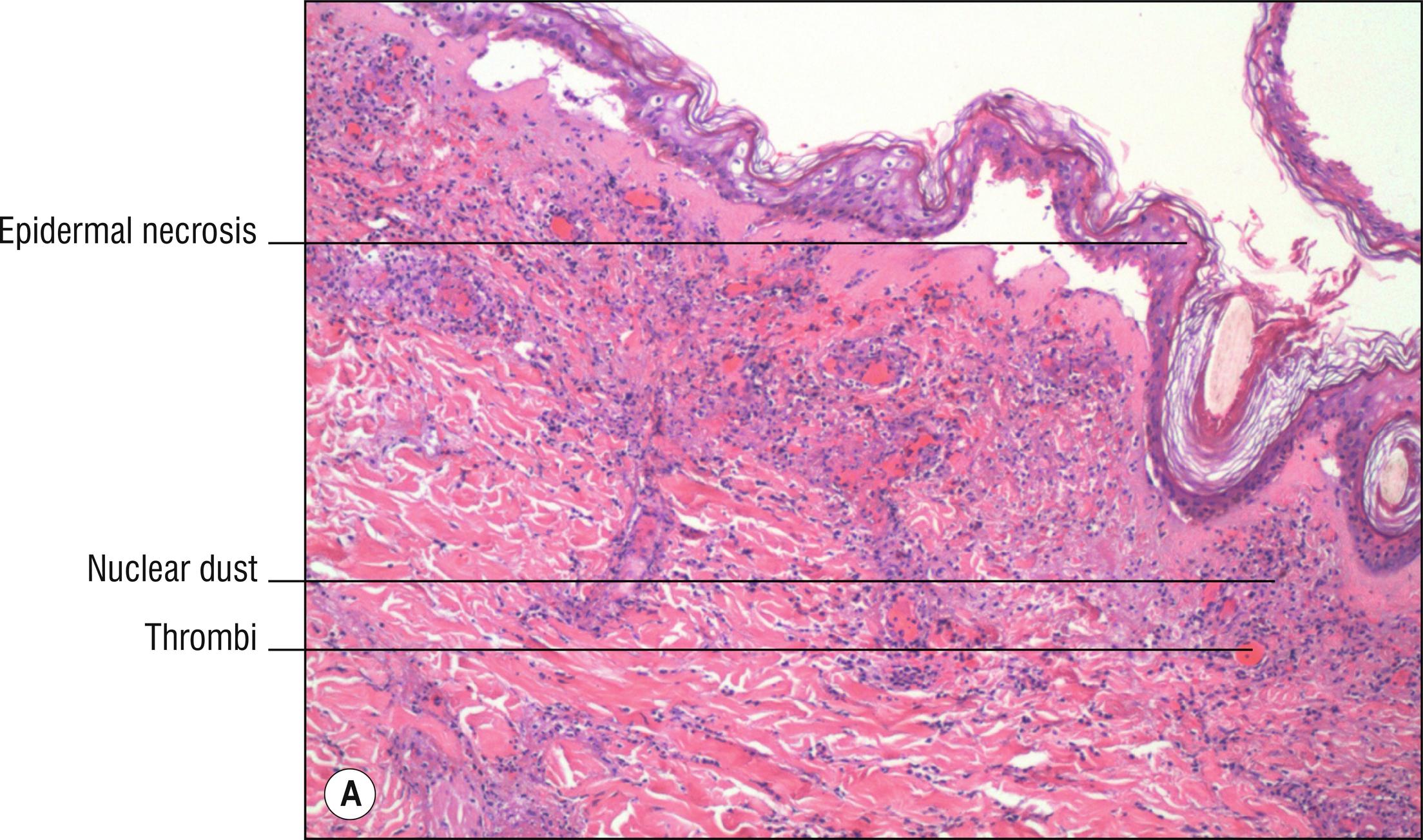
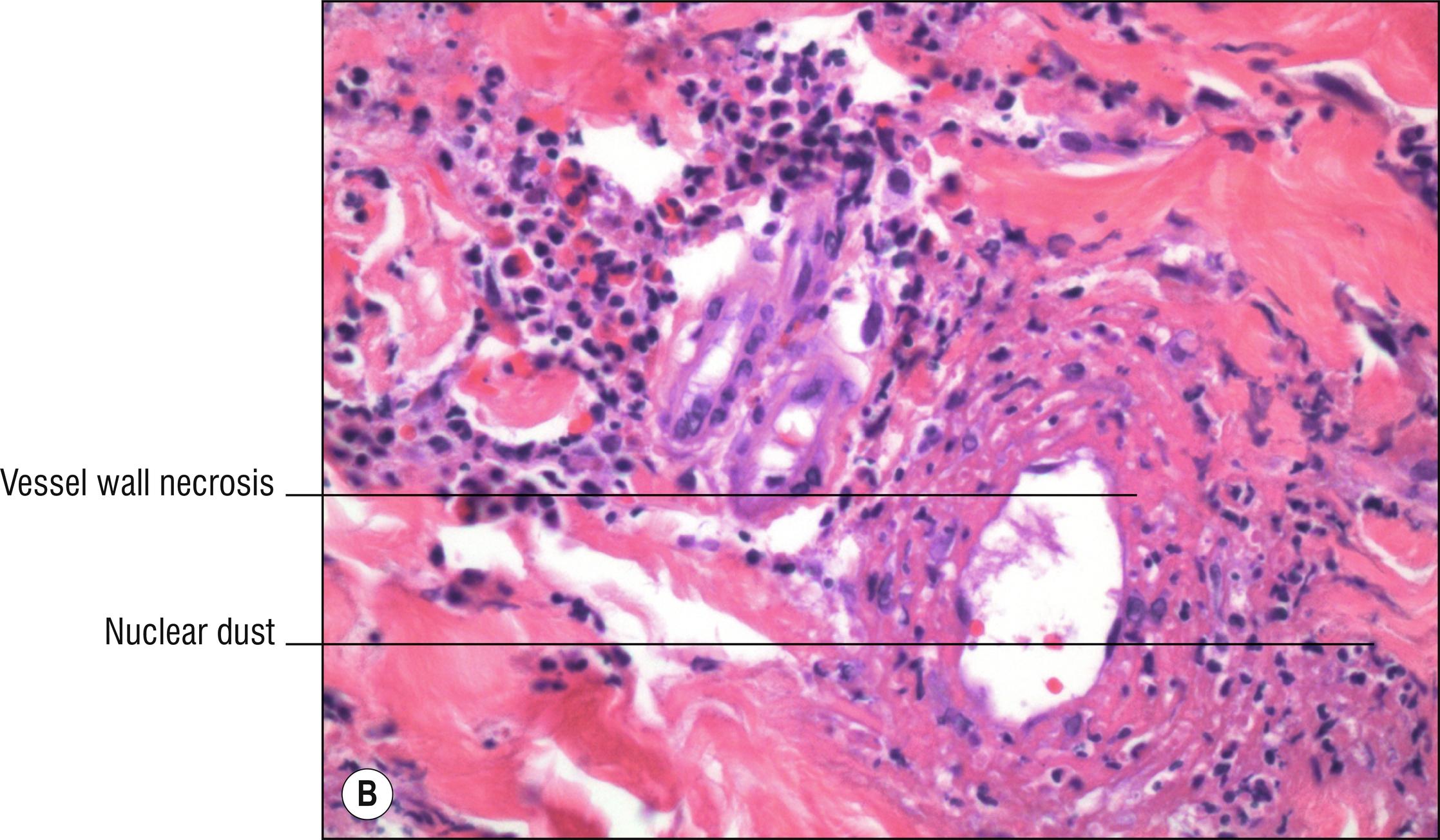
Like Reiter’s syndrome (2.8), this is another disease with a name change based upon unsavory political associations of the person for whom the condition was named, hence the name GPA is in vogue. Uncommon systemic granulomatous vasculitis mainly with sinusitis , pulmonary disease, nephritis (1.66), and c-ANCA antibodies (cytoplasmic antineutrophil cytoplasmic antibodies). Cutaneous palpable purpura (1.120), necrotic nodules, or ulcers (1.141) occur in one-third of patients.
Epidermis often necrotic or ulcerated
Non-specific perivascular inflammation in some cases
Vasculitis of small arteries and veins involving neutrophils, lymphocytes, plasma cells, and (rarely) eosinophils
Granulomatous inflammation in blood vessels and in surrounding dermis often, sometimes palisading
Thrombi often (1.137), resulting in extensive necrosis
Extravasation of erythrocytes (1.40)
1.Microscopic polyangiitis (MPA): acute viral-like syndrome of adults, neutrophilic vasculitis of arterioles as well as venules (4.1) mainly separated as an “entity” by regular presence of p-ANCA (c-ANCA antibodies are also common), and kidney disease. Pulmonary disease and palpable purpura of skin occur in one-third of patients.
Become a Clinical Tree membership for Full access and enjoy Unlimited articles
If you are a member. Log in here